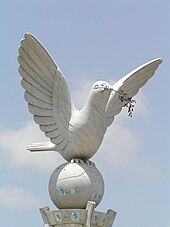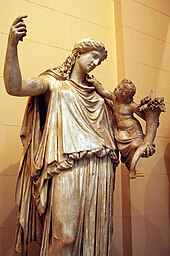
Back Vrede Afrikaans Frieden ALS Paz AN शांति ANP سلام Arabic ܫܠܡܐ (ܫܝܢܐ) ARC سلام ARY سلام ARZ Paz AST Sülh Azerbaijani


Peace is a state of harmony in the absence of hostility and violence. In a societal sense, peace is commonly used to mean a lack of conflict (such as war) and freedom from fear of violence between individuals or groups.
Promotion of peace is a core tenet of many philosophies, religions, and ideologies, many of which consider it a core tenant of their philosophy. Some examples are, faiths such as Buddhism and Islam, important figures like Gandhi, and throughout literature like "Perpetual Peace: A Philosophical Sketch" by Immanuel Kant, "The Art of Peace" by Morihei Ueshiba, or ideologies that strictly adhere to it such as Pacifism within a sociopolitical scope. It is a frequent subject of symbolism and features prominently in art and other cultural traditions.
The representation of peace has taken many shapes, with a variety of symbols pertaining to it based on culture, context, and history; each with their respective symbolism whose nature can be very complex. An example, being during post-violence, in contexts where intense emotions, these symbols can form to evoke unity and cooperation, described as to fill groups of people with pride and connection, yet the symbolism could also possibly form to convey oppression, hatred, or else.[2] As such, a universal definition for peace does not concretely exist but gets expanded and defined proactively based on context and culture, in which it can serve many meanings not particularly benevolent in its symbolism.
"Psychological peace" (such as peaceful thinking and emotions) is less relatively well-defined, yet perhaps[further explanation needed] a necessary precursor to establishing "behavioural peace". Peaceful behaviour sometimes results from a "peaceful inner disposition". It has been argued by some that inner qualities such as tranquility, patience, respect, compassion, kindness, self-control, courage, moderation, forgiveness, equanimity, and the ability to see the big picture can promote peace within an individual, regardless of the external circumstances of their life.[3]
- ^
- "UN Logo and Flag". United Nations. Archived from the original on 26 December 2020. Retrieved 10 December 2020.
- "International Day of Peace 2020 Poster" (PDF). UN.org. United Nations. Archived from the original (PDF) on 24 September 2020. Retrieved 10 December 2020.
- ^ Moeschberger, Scott L.; DeZalia, Rebekah A. Phillips (14 May 2014). Symbols that Bind, Symbols that Divide: The Semiotics of Peace and Conflict. Springer. ISBN 978-3-319-05464-3.
- ^ Galtung, Johan (31 July 1996). Peace by Peaceful Means: Peace and Conflict, Development and Civilization (1st ed.). Los Angeles: SAGE Publications Ltd. ISBN 978-0-8039-7511-8.